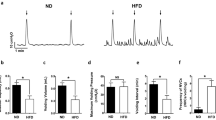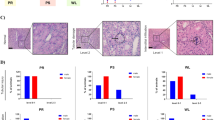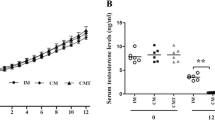Abstract
The metabolic syndrome and diabetes are associated with bladder dysfunction in many people. Peroxisome proliferator-activated receptors (PPARs) may play a role in the effects of the metabolic syndrome on bladder smooth muscle (BSM). The purpose of this study was to determine if there are gender and genetic differences in PPAR levels in BSM. We measured PPAR levels using quantitative PCR in BSM from male Yucatan swine and male and female Ossabaw Island swine, which is a model for the metabolic syndrome. Male Ossabaw swine had 0.732 ± 0.111 the amount of PPAR-α mRNA as male Yucatan swine (P < 0.05), suggesting a genetic difference in PPAR-α levels. This difference may possibly contribute to the incidence of metabolic syndrome in the Ossabaw model compared to the Yucatan model. PPAR-δ mRNA was 2-fold higher in male Ossabaw swine than in female Ossabaw swine, with no significant differences in PPAR-α levels. However, PPAR-γ mRNA was 4.067 ± 0.134 times higher in female Ossabaw swine than in their male counterparts (P < 0.001). Changing the percentage of calories derived from fat did not alter any PPAR mRNA levels. Thus, PPAR-δ and PPAR-γ mRNA levels in male and female Ossabaw swine BSM are not only different, but may also result in gender differences in lipid metabolism in bladder smooth muscle. We conclude that PPAR profiles in BSM may contribute to the susceptibility of BSM to lipotoxicity in the metabolic syndrome.


Similar content being viewed by others
References
Ford ES, Giles WH, Mokdad AH (2004) Increasing prevalence of the metabolic syndrome among U.S. adults. Diabetes Care 27:2444–2449
Eckel RH, Grundy SM, Zimmet PZ (2005) The metabolic syndrome. Lancet 365:1415–1428
Grundy SM, Brewer HB Jr, Cleeman JI, Smith SC Jr, Lenfant C, American Heart A and National Heart LaBI (2004) Definition of metabolic syndrome: Report of the National Heart, Lung, and Blood Institute/American Heart Association conference on scientific issues related to definition [see comment]. Circulation 109:433–438
McGill HC Jr, McMahan CA, Herderick EE, Zieske AW, Malcom GT, Tracy RE, Strong JP and Pathobiological Determinants of Atherosclerosis in Youth Research G (2002) Obesity accelerates the progression of coronary atherosclerosis in young men [see comment]. Circulation 105:2712–2718
Neel J (1962) Diabetes mellitus: a “thrifty” genotype rendered detrimental by “progress”? Am J Hum Genet 14:353–362
Marx J (2002) Unraveling the causes of diabetes. Science 296:686–689
Listenberger LL, Ory DS, Schaffer JE (2001) Palmitate-induced apoptosis can occur through a ceramide-independent pathway. J Biol Chem 276:14890–14895
Listenberger LL, Han X, Lewis SE, Cases S, Farese RV Jr, Ory DS, Schaffer JE (2003) Triglyceride accumulation protects against fatty acid-induced lipotoxicity. Proc Natl Acad Sci USA 100:3077–3082
de Vries JE, Vork MM, Roemen TH, de Jong YF, Cleutjens JP, van der Vusse GJ, van Bilsen M (1997) Saturated but not mono-unsaturated fatty acids induce apoptotic cell death in neonatal rat ventricular myocytes. J Lipid Res 38:1384–1394
Maedler K, Spinas GA, Lehmann R, Sergeev P, Weber M, Fontana A, Kaiser N, Donath MY (2001) Glucose induces beta-cell apoptosis via upregulation of the Fas receptor in human islets. Diabetes 50:1683–1690
Cnop M, Hannaert JC, Hoorens A, Eizirik DL, Pipeleers DG (2001) Inverse relationship between cytotoxicity of free fatty acids in pancreatic islet cells and cellular triglyceride accumulation. Diabetes 50:1771–1777
Hardy S, Langelier Y, Prentki M (2000) Oleate activates phosphatidylinositol 3-kinase and promotes proliferation and reduces apoptosis of MDA-MB-231 breast cancer cells, whereas palmitate has opposite effects. Cancer Res 60:6353–6358
Paumen MB, Ishida Y, Muramatsu M, Yamamoto M, Honjo T (1997) Inhibition of carnitine palmitoyltransferase I augments sphingolipid synthesis and palmitate-induced apoptosis. J Biol Chem 272:3324–3329
Schaffer JE (2003) Lipotoxicity: when tissues overeat. Curr Opin Lipidol 14:281–287
Ellenberg M (1980) Development of urinary bladder dysfunction in diabetes mellitus. Ann Intern Med 92:321–323
Buck AC, McRae CU, Chisholm GD (1974) The diabetic bladder. Proc Royal Soc Med 67:81–83
Lincoln J, Haven AJ, Sawyer M, Burnstock G (1984) The smooth muscle of rat bladder in the early stages of streptozotocin-induced diabetes. Br J Urol 56:24–30
Rohrmann S, Smit E, Giovannucci E, Platz EA (2005) Association between markers of the metabolic syndrome and lower urinary tract symptoms in the Third National Health and Nutrition Examination Survey (NHANES III). Int J Obes 29:310–316
Ng Y, Husain I, Waterfall N (2003) Diabetes mellitus and bladder cancer – an epidemiological relationship? Pathol Oncol Res 9:30–31
Yoshimura N, Chancellor MB, Andersson KE, Christ GJ (2005) Recent advances in understanding the biology of diabetes-associated bladder complications and novel therapy. BJU Int 95:733–738
Kudlacz EM, Gerald MC, Wallace LJ (1989) Effects of diabetes and diuresis on contraction and relaxation mechanisms in rat urinary bladder. Diabetes 38:278–284
Pitre DA, Ma T, Wallace LJ, Bauer JA (2002) Time-dependent urinary bladder remodeling in the streptozotocin-induced diabetic rat model. Acta Diabetol 39:23–27
Hardin CD, Kleiber BD, Roberts TM (2003) Mitochondrial oxidative substrate selection in porcine bladder smooth muscle. J Urol 170:2063–2066
Plutzky J (2003) Medicine. PPARs as therapeutic targets: reverse cardiology? [comment]. Science 302:406–407
Ferre P (2004) The biology of peroxisome proliferator-activated receptors: relationship with lipid metabolism and insulin sensitivity. Diabetes 53:S43–50
Berger J, Moller DE (2002) The mechanisms of action of PPARs. Annu Rev Med 53:409–435
Chen YE, Fu M, Zhang J, Zhu X, Lin Y, Akinbami MA, Song Q (2003) Peroxisome proliferator-activated receptors and the cardiovascular system. Vitam Horm 66:157–188
Smith SA (2002) Peroxisome proliferator-activated receptors and the regulation of mammalian lipid metabolism. Biochem Soc Trans 30:1086–1090
Xu HE, Lambert MH, Montana VG, Parks DJ, Blanchard SG, Brown PJ, Sternbach DD, Lehmann JM, Wisely GB, Willson TM, Kliewer SA, Milburn MV (1999) Molecular recognition of fatty acids by peroxisome proliferator-activated receptors. Mol Cell 3:397–403
Oliver WR Jr, Shenk JL, Snaith MR, Russell CS, Plunket KD, Bodkin NL, Lewis MC, Winegar DA, Sznaidman ML, Lambert MH, Xu HE, Sternbach DD, Kliewer SA, Hansen BC, Willson TM (2001) A selective peroxisome proliferator-activated receptor delta agonist promotes reverse cholesterol transport. Proc Natl Acad Sci USA 98:5306–5311
Wang YX, Lee CH, Tiep S, Yu RT, Ham J, Kang H, Evans RM (2003) Peroxisome-proliferator-activated receptor delta activates fat metabolism to prevent obesity. Cell 113:159–170
Dyson M, Alloosh M, Vuchetich J, Mokelke E, Sturek M (2006) Components of metabolic syndrome and coronary artery disease in female ossabaw swine fed excess atherogenic diet. Comp Med 56:37–47
Otis CR, Wamhoff BR, Sturek M (2003) Hyperglycemia-induced insulin resistance in diabetic dyslipidemic Yucatan swine. Comp Med 53:53–64
Brown JS, Seeley DG, Fong J, Black DM, Ensrud KE, Grady D (1996) Urinary incontinence in older women: who is at risk? Study of Osteoporotic Fractures Research Group. Obstet Gynecol 87:715–721
Schmidbauer J, Temml C, Schatzl G, Haidinger G, Madersbacher S (2001) Risk factors for urinary incontinence in both sexes. Analysis of a health screening project. Eur Urol 39:565–570
Unger RH (2002) Lipotoxic diseases. Annu Rev Med 53:319–336
Acknowledgments
Additional bladder tissue was graciously provided by Dr. Harold Laughlin’s laboratory. We thank members of the Laughlin lab and Sturek lab, particularly Eric Mokelke, for their help in collecting the bladders. We also thank Dr. Ronald Terjung for allowing us use of his ABI 7000.
Author information
Authors and Affiliations
Corresponding author
Rights and permissions
About this article
Cite this article
Mattern, H.M., Lloyd, P.G., Sturek, M. et al. Gender and genetic differences in bladder smooth muscle PPAR mRNA in a porcine model of the metabolic syndrome. Mol Cell Biochem 302, 43–49 (2007). https://doi.org/10.1007/s11010-007-9423-8
Received:
Accepted:
Published:
Issue Date:
DOI: https://doi.org/10.1007/s11010-007-9423-8




